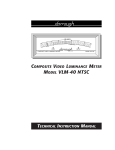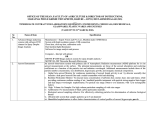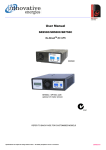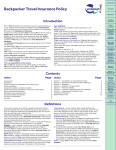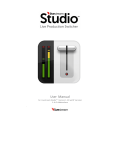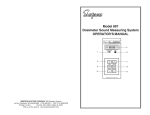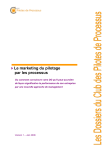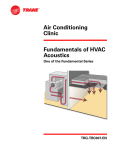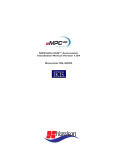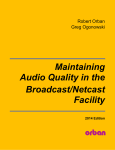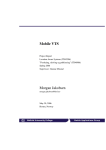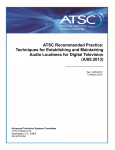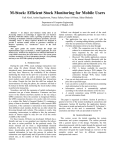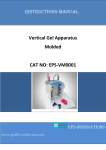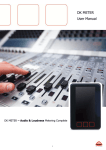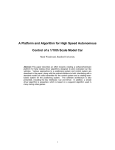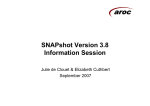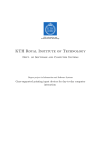Download Orban v2.8.0 Loudness Meter README
Transcript
Orban Loudness Meter for Windows README 2014 June 10 (version 2.8.0) V2.7 is a major upgrade that adds support for up to 7.1-channel surround and the ability to analyze audio and the audio parts of video files offline for their BS.1770-3 Integrated Loudness, EBU R 128 LRA, highest reconstructed peak level, and number of reconstructed peaks above 0 dBfs. It will graph the BS.1770-3 Integrated Loudness and peak swings of the CBS Loudness Meter as a function of time, and can display a histogram of the BS.1770-3 Integrated Loudness. At this writing, v2.7 is only available for Windows Vista/7/8. It is not compatible with Windows XP and earlier. We will continue to make v2.0 available for Mac and Windows XP users. New features in V2.0 include full support for BS.1770-3 and EBU R 128, logging, manual mode (start/stop), and oversampled peak measurement that accurately indicates the peak level of the audio after D/A conversion. In addition to a Windows® version, a Mac version is now available. Orban makes this software available free of charge, subject to the provisions of the License Agreement displayed by the software installer. This software is sponsored by Orban’s TV loudness controllers. We invite users who need highest-performance automatic loudness control to check out our controllers at: http://www.orban.com/products/television Revision History Version 1.0.0 was the original public beta release. Version 1.0.1: Reduces CPU load caused by refreshing the meter’s display. This allows slower computers to operate at the meter’s maximum 100 Hz refresh rate, minimizing flicker. Changes the color scheme to improve appearance and to make 2 the meters easier to read. Changes the graphic design of the single-bar meter display elements like peak hold to make them easier to read and to prevent them from being obscured. On startup, checks whether the computer’s CPU supports the SSE2 instruction set and exits gracefully if it does not. Increase the gain of the VU meter by 10 dB for a given setting of the VU Meter Gain control. When the control is set to 0 dB and the meter is fed by a sinewave, the VU meter will now display the same level as the absolute peak meter. Clarifies the readme (this document) to better explain how the meter interacts with your computer’s sound device(s). Moves the Audio Input selector to the Settings page. Version 1.0.2: Causes the meters to be reset when disabled. In computers running Windows 2000, the software now gives the correct result when testing whether the computer’s CPU supports the SSE2 instruction set. Version 1.0.3: To reduce CPU load and allow more versatile scaling of the loudness meter window, V1.0.3 uses Windows DirectDraw and requires DirectX 7 or higher to run. Version 2.0.3: Is available for Macs running OS X10.6 and higher. Supports both the ITU BS.1770-1 and BS.1770-3 standards, user selectable. BS.1770-3 adds gating to the previous BS.1770-1 standard so that the meter ignores silence and is weighted toward louder program material, which contributes most to a listener’s perception of loudness. BS.1770-3 indicates only sounds that fall within a floating window that extends from the loudest sounds within the preset integration period to sounds that are 10 dB quieter than the loudest sounds. Supports EBU R 128 measurements. R 128 calls for three meters: an ungated “momentary” meter having a time integration window 3 of 400 ms, an ungated “short-term” meter having a time integration window of 3 seconds, and an “integrated” meter, having a user-selectable time integration window and gating as specified in BS.1770-3. The Orban application provides a dedicated meter for the “momentary” indication while indicating the “short-term” and “integrated” loudness on a second meter, where a yellow bar displays the short-term loudness and a single cyan segment indicates the integrated loudness. A numerical display of the integrated loudness appears to the right of the meter. The Orban meter implements the “loudness range” measurement per EBU – TECH 3342, which is incorporated into R 128 by reference. The “loudness range” measurement is most commonly used in Manual Mode to assess the dynamic range of entire program segments. EBU – TECH 3341 calls for two selectable meter scales and two selectable ranges. The scales are either absolute (in units of LUFS or LKFS, which are the same) or are relative with respect to a user-selectable reference level (which usually corresponds to the program’s Dolby Digital® dialnorm metadata value [in dB] and whose units of measure are LU or LK, which are the same). ATSC A/85, Annex K (“Requirements for Establishing and Maintaining Audio Loudness of Commercial Advertising in Digital Television When Using Non-AC-3 Audio Codecs”) and EBU – TECH 3344 (“Practical guidelines for distribution systems in accordance with EBU R 128”) provide instructions on how to choose the reference level in systems that do not use Dolby Digital to convey the program to the consumer. The ATSC A/85 2011, ITU-R BS.1770-3, and various EBU R 128related documents are available as free downloads and can easily be located with a search engine. Allows manual start/stop operation of the meter per BS.1770-3. Extends the maximum integration period to three hours for both program monitoring and manual modes. This allows the meter to measure the integrated loudness and LRA of most long-form program material such as feature films. Changes the scale of the CBS Loudness Meter to match the scale of the EBU meters. This allows the readings of the BS.1770 and CBS meters to be compared easily. In addition, it changes the scaling of the “CBS Loudness Gain” control so that +10 dB on the 4 V1 meter is equivalent to “0 dB” on the V2 meter. Supports Annex 2 of ITU-R Rec. BS.1770-3 (“Considerations for accurate peak metering of digital audio signals”) by adding a peak-reading meter with a sample rate of 384 kHz and a recovery characteristic that is the same as a PPM, which we chose arbitrarily to make the meter easy to read. This “Reconstructed Peak” meter indicates the peak value of the signal following D/A conversion (including the reconstruction filter) with an accuracy of better than 0.2 dB, assuming that this signal path has constant group delay and a low frequency cutoff low enough to avoid introducing tilt into the waveform. This meter indicates “intra-sample peaks,” which can cause clipping in the analog section of a playback device even if the magnitude of the digital samples is constrained to 0 dBFS. This is a serious problem with many popular playback devices. Assuming that the D/A converter and reconstruction filter in a playback device have constant group delay and that response in the analog signal path is flat to DC, the worst-case overshoot is +3 dBFS, as exemplified by a sinewave whose frequency is 25% of the sampling frequency and where the samples are taken 45 degrees before and after the zero-crossings of the sinewave. If the “Reconstructed Peak” meter indicates higher than 0 dBFS, this indicates that clipping will occur in many playback devices. The Orban meter does not implement the optional “HF preemphasis” and “DC block” blocks in the block diagram in Section 2 of Annex 2 of the BS.1770-3 standard. This is because the choice of pre-emphasis and DC blocking frequency characteristics is completely arbitrary, attempting to compensate for non-constant group delay and DC blocking that may or may not exist in the analog signal path of a given target playback device and which may or may not cause analog clipping from low frequency tilt even if they do exist. See http://www.indexcom.com/tech/0dBFS+ for a more detailed discussion of intersample peaks. Oversamples the PPM attack time processing to 384 kHz. This allows the meter to match the attack characteristics of EBU Tech. 3205-E more closely because this standard was originally developed for analog meters that are measuring analog signals. Permits the important meter readings to be logged into a comma- 5 delimited text file that can be imported into any spreadsheet or graphing program for further analysis and display. The sample period of the log file is user adjustable via the “Logging Interval” control. Adds support for the Microsoft WASAPI Loopback Interface (Windows Vista and 7/8 only). WASAPI Loopback eliminates the requirement for a sound device to support Wave I/O or what is traditionally called “Stereo Mix” to play and record/monitor files played through Windows Audio. Fixes a bug that caused the sample peak meter to indicate the values of positive-going peaks incorrectly. Extends the VU Gain control range to +20 dB. This allows the VU meter to be aligned to SMPTE (–20 dBFS) or EBU (–18 dBFS) lineup level. Version 2.0.6: Fixes a bug where the LRA display would not reset if the 1770 meter is reset while paused. Adds Reset and Pause/Resume buttons for the LRA readout. Limits LRA readout to BS.1770-3 mode. Changed the clamping range for the BS.1770-3 long-term integrated readout to -70 LK on the lower bound, with no upper bound. Hides the refresh rate slider in Windows Vista/7/8. It is still displayed for Windows XP and Mac OS X. Fixes a potential race condition in the wave input code where the flags field was not being explicitly cleared in each wave buffer header. Version 2.0.8: Adds support for ASIO devices. Note that to feed the Orban meter while connected to another application, a given ASIO device must have a “multi-client” driver, which many ASIO devices do not have. Adds a “Channels” drop-down, which allows you to choose which audio channels the Loudness Meter monitors when a given sound 6 device supports more than two channels. Version 2.7.6: Adds support for up to 7.1-channel surround. Adds support for offline, faster-than-real-time file analysis. Removes support for Windows XP and does not yet support the Mac OS. Corrects a bug that caused the integration time of the BS.1770-3 Short-Term meter to be less than 3 seconds. Version 2.7.8: Corrects a bug that caused the BS.1770 Integrated Loudness to be indicated incorrectly in the Analysis tab. Corrects a bug that could cause the number of reconstructed peaks above 0 dBFS to be miscounted in the Analysis tab. Version 2.8.0: Corrects a bug that caused the graph of BS.1770 Integrated Loudness in the Analysis tab to show the progress of the wholefile loudness integration process (i.e. the computation of the number shown in the BS.1770 Integrated Loudness box). Instead of tracking the localized loudness over time, this bug caused the graph to converge on the value of the whole-file Integrated Loudness at the right graph margin. V2.8.0 displays the BS.1770 loudness as a function of time, using the value of the BS.1770 Integration Time control to set the time constant of the loudness integrator. The loudness graph is delayed with respect to the time-domain waveform by an amount equal to the integration time, and this lag may cause the loudness and time domain waveforms to be slightly misaligned graphically when long integration times are used. Note that if you change the value of the BS.1770 Integration Time control, the graph for a given file will not be recalculated unless you force a recalculation by quitting and restarting the Loudness Meter application, or by removing and then restoring the filename from the left window. 7 Corrects a bug that prevented BS.1770-2+ Integration Time settings of greater than 60 seconds from being saved and restored when quitting and then restarting the meter application. The maximum allowable integration time depends on the 1770 mode. The meter now checks the mode and limits the maximum time to 60 seconds in -1 mode and to three hours in -2+ mode. Hardware and Operating System Requirements Microsoft Windows® Vista (SP1 or greater), or 7/8. Windows DirectX 7 or higher installed. 1.5 GHz or faster Intel Pentium 4 or Intel-compatible processor that implements the SSE2 instruction set. Note that this is a function of the processor, not the operating system. http://en.wikipedia.org/wiki/SSE2 1024x768 or larger display. 70 megabytes of free RAM in which to run the application. The Orban meter responds to audio signals received by one of the audio input devices on your computer, either sound device hardware inputs or player application outputs that feed application inputs. The meter uses the Windows Audio Session API (WASAPI) Loopback or ASIO. WASAPI allows the meter to monitor playout from any Windows Audio player application and eliminates the Wave I/O or Stereo Mix requirements. (Google ‘Microsoft WASAPI Loopback’ for more information.) Only WASAPI Loopback support allows you to meter an audio device without Wave I/O or Stereo Mix. Level calibration is unnecessary because the WASAPI Loopback is internally unity-gain. On a laptop sound system for example, it is possible to change the audio level or even mute the speakers and Orban Meter’s indication will not change. The only supported sample rates for the WASAPI interface are 44.1 kHz, 48 kHz, 88.2 kHz, 96 kHz, 176.4 kHz and 192 kHz. This is a good time to consider upgrading to Microsoft Windows 7/8. However, without the hotfix mentioned below, Windows 7 and Server 2008 provide low-quality sample rate conversion under some scenarios. Therefore, we recommend updating all Microsoft Windows 7/Server 2008 R2 computers with the Microsoft Audio SRC Hotfix for 8 improved audio sample rate converter performance: http://support.microsoft.com/kb/2653312 More details on the Microsoft Audio Sample Rate Converter are available here: http://www.indexcom.com/tech/WindowsAudioSRC/ Installation If you previously installed v2.0.3 in Windows, uninstall it prior to installing a later version of the Loudness Meter by using Windows Add/Remove Programs. This will prevent having two versions of OrbanLoudnessMeter.exe (and two shortcuts with the same name pointing to two different versions). Versions other than 2.0.3 are uninstalled automatically when a higher version is installed. To install the Loudness Meter, run setup_Free_Orban_Loudness_Meter_x.x.x.exe. where x.x.x is the version number of the software. Follow the installer’s prompts. Please note that although Orban offers this executable version of the Loudness Meter software free of charge to end users, this software is not in the public domain and Orban retains all rights and indemnities to maximum extent permitted by law. To complete the installation, you must agree to the License Agreement that the installer presents to you. If you disagree, the installer will allow you to cancel the installation. Setup and Operation Launch the Loudness Meter via the icon on the desktop or in the Quick Launch bar. Click the Settings tab. This allows you to set several operating parameters for the meters. 9 SETTINGS PAGE In the Audio Input drop-down, choose which Windows installed sound device the Loudness Meter should monitor, and, if the sound device supports more than two channels, which channels the Loudness Meter should monitor. Use the Settings > Audio > Channels control to set the number of channels (stereo, 5.1, or 7.1) that are monitored. If you wish to monitor surround, the Audio Device that is selected (typically a sound card or sound device onboard the computer’s motherboard) must support multichannel playback. Usually this is the Speakers device in Windows, and you must configure the Speakers device in the Windows Sound control panel for 5.1 or 7.1 surround as appropriate. The capabilities of the Speakers device are determined by the driver for the hardware sound device associated with it. If you are attempting to connect the Loudness Meter to an ASIO device, the ASIO device must have a multi-client driver to record or play while also driving the Loudness Meter. Refer to ASIO: If the meter issues an error message and/or an ASIO device does not appear on page 14. In general, the Loudness Meter will only be able to monitor ASIO hardware inputs unless the ASIO sound device has a control panel that permits routing. For this reason, we expect the Loudness Meter to be more useful with WAVE drivers than with ASIO drivers, because the Loudness Meter uses WASAPI to monitor sound device inputs and outputs in Windows. The Meter Refresh Rate lets you trade off the solidity of the display against CPU usage. If the application uses too much CPU (as indicated in the Windows Task Manager Performance tab), reduce the meter’s Refresh Rate as needed. Best display quality occurs at 100 Hz. This control is only available in Mac OS X. The CBS Loudness Gain sets the reference level of the CBS meter. “0 dB” on V2 of the Orban Meter is equivalent to “+10 dB” in the V1.0.x meter and was chosen arbitrarily to approximately match the CBS long-term indication (cyan bar) to the BS.1770 meter. The “Meter Scale” control toggles the scales of the BS.1770 meters and the CBS meter between “Relative” (with reference to the “Reference Level” control setting) and “Absolute.” In “Absolute” mode, the BS.1770 indicates LUFS (aka LKFS) as 10 defined in the BS.1770-3 and “EBU – TECH 3341” standards. The “Meter Range” control allows you to select the “EBU +9” and “EBU +18” scales per the EBU – TECH 3341 standard. This control applies only to the BS.1770 and CBS meters. The CBS Peak Averaging Time allows you to set the time window over which the CBS long-term averaging algorithm works. We prefer 3 to 4 seconds. Longer times will smooth out the indication but will also look further back into the history of the program material, which may be undesirable if you are trying to use the meter for real-time program monitoring. The “ITU BS.1770 Type” allows the meter to obey the BS.1770-1 or BS.1770-3 standards. When BS.1770-1 is selected, the BS.1770-1 meter uniformly integrates over a time window equal to the “Integration Time” control setting. Note that the BS.1770-1 measurement gives equal weight to all samples within the time window specified for “Momentary,” “Short-Term and “Integrated” measurements; newer samples are not weighted higher than older samples. This is also true of the BS.1770-3 “integrated” measurement except that the gating process will discard some samples. In BS.1770-3 mode, the meter indicates the “short-term” loudness (three-second integration time with no gating), while the cyan bar and numerical read-out indicate the gated, “integrated” loudness, where the integration time follows the setting of the “Integration Time” control. The maximum allowable integration time depends on the 1770 mode. The meter checks the mode and limits the maximum time to 60 seconds in -1 mode and to three hours in -2+ mode. The “BS.1770 Momentary” meter continues to operate with an ungated 400 ms integration time regardless of the “ITU BS.1770 Type” setting. The “LRA Integration Time” control sets the Loudness Range integration time per EBU – TECH 3342. (Note that this setting is independent of the BS.1770 Integration Time.) The default setting is 300 seconds. In most cases, this measurement is only of interest in Manual Mode and in the Analysis window, in which case it can suggest the long-term dynamic range of a selected program segment. 11 The LRA integration only operates when the meter is in BS.1770-3 mode. The “PPM Attack Time” control determines whether the PPM’s attack time is 10 ms or 5 ms, allowing the meter to emulate several different variants of the PPM standard. The “VU Meter Gain” control sets the reference level of the VU meter with respect to digital full scale. Because this meter’s scale is different from that of a standard VU meter, you will have to decide what indication you want to correspond to the customary “0 VU.” Note that the VU meter is defined as an averaging meter, which the Orban VU meter is. The average value of a sinewave is 3.9224 dB below its peak value. By design, when the Orban meter’s VU Meter Gain is set to 0 dB, the VU meter indicates what might be called “equivalent sinewave peak” with respect to digital full-scale. In other words, a VU Meter Gain setting of 0 dB makes a 0 dBfs sinewave indicate 0 on the VU meter, not –3.994. The “Log File Logging Interval” control determines how often meter readings are logged after the “Write to log file” button (in the “Meters” page) is activated. All relevant control settings in the Settings page are written to a header in the file. The items logged are: Date, Time, CBS Minimum, CBS Maximum, CBS Average Peak Minimum, CBS Average Peak Maximum, Left Peak Minimum, Left Peak Maximum, Right Peak Minimum, Right Peak Maximum, BS.1770-1 Minimum, BS.1770-1 Maximum, BS.1770-3 Integrated, LRA (loudness range), Left Reconstructed Peak, And Right Reconstructed Peak. The “Folder” control allows you specify a folder for the Loudness Meter to monitor. Anytime that a new file is added to the folder, the Loudness Meter will analyze it automatically and the results will be available in the Analysis tab when you click on the file of interest in the file list pane. The “Folder Watch” control activates or defeats automatic analysis of new file in the Watched folder. The “Loudness Alarm Level” and “Peak Alarm Level” are not yet functional. 12 METERS PAGE: OPERATING THE REAL-TIME METER Start and stop all measurements by clicking the Start/Stop button at the bottom of the screen. “Stop” mode clears all measurements. Some settings can only be adjusted when the meter is stopped. You can click the small button to the left of each individual meter to start or stop it while allowing others to continue operating. The double-arrow icon to the left of the start/stop button resets the meter. To use the meter in manual mode: If the meter is running, stop it by using the main start/stop button on the bottom of the screen. This will “zero-out” all meters. In the Settings tab, set the “Integration Time” and “LRA Integration Time” to be longer than the duration of the program being measured. The maximum available integration times are three hours. Click the main start/stop button on the bottom of the screen to start the measurement. When the program material finishes, click the small circle icon to the left of either BS.1770 meter to freeze the indications of the BS.1770 meters and the LRA indictor. This allows you to easily read the integrated loudness of the program segment. Note that clicking the double-arrow icon to the left of either BS.1770 meter clears the BS.1770 and LRA measurements. The “Write to log file” button causes the meter to write a new log file each time the meter is started. Each log file is identified by date and time (in 24-hour format) using the host computer’s clock as a reference. The log file is placed in the My Documents / Orban Audio Loudness Meter folder on the host computer. ANALYSIS PAGE: ANALYZING FILES Starting with version 2.7, the software can perform offline, faster-thanreal-time analysis of audio files and the audio part of video files in many different uncompressed and compressed formats, including WAV, BWF, AIFF, FLAC, OGG, MP3, WMV, ASF, WM, WMA, MP4A, MP4M, MP4V, MOV, AAC, AVI, and AC3. The meter uses Microsoft Media Foundation (http://msdn.microsoft.com/enus/library/windows/desktop/dd757927(v=vs.85).aspx) to achieve must of its file support. 13 If, by using the “Folder” control in Settings, you have chosen a folder to monitor automatically and have turned “Folder Watch” on, all files in that folder will appear in the left pane of the Analysis window. Click a file is display its BS.1770-3 Integrated Loudness, EBU R 128 LRA, highest reconstructed peak level, and number of reconstructed peaks above 0 dBfs, all as single numbers that are integrated over the entire file. Depending on the setting of Settings > Display > Meter Scale, the readings will either be absolute or relative to Settings > Display > Reference Level. For example, if your organization has a target loudness of –24 LKfs/LUfs, you can set these controls to “–24” and “Relative,” and the analysis will display the BS.1770 Integrated and CBS Loudness indications relative to –24 LKfs/LUfs. The graphic pane shows the amplitude envelope of the file as a function of time from the beginning to the end of the file. Setting the dropdown the “Line Graph” overlays the BS.1770-3 Integrated Loudness (in time increments set by Settings > BS.1770 > Integration Time) and the CBS peak loudness (the peak swings of the CBS meter). Use the buttons below the graphic pane to select the color of these displays. (The default is “BS.1770 Integrated” in cyan and the “CBS” in dark blue. These are the same colors used in the built-in loudness meters of the Orban loudness controllers shown in the Orban tab.) Setting the dropdown to “Histogram” shows the relative probability that a given BS.1770-3 measurement will occur, where the measurement is shown on the horizontal axis. This approximates a probability density function and is another way to look at loudness range that may provide more insight than just a single “LRA” number. The axis is calibrated to LK/LU or LKfs/LUfs depending on whether Settings > Display > Meter Scale is set to “Relative” or “Absolute” respectively. The more tightly clustered the histogram bars are, the more consistent a given file’s loudness is. To manually add and subtract files from the analysis window, use the + and – buttons below the window. The + button opens a dialog box that allows you to select one or more files for analysis. To select multiple files, hold down the <Ctrl> key of your computer’s keyboard while clicking the files you wish to analyze. When you have finished, click the Open button. You can also select contiguous files by first clicking the top file and then, while holding down the Shift key on your computer’s keyboard, clicking the bottom file. Multiple Instances You can run more than one instance of the meter simultaneously and each instance can have its own settings. For example, each instance can receive the output of a different Audio Device. The settings in a given 14 instance will persist only as long as that instance is open. The next time the meter is started up, the last control to be adjusted in any instance will govern the setting of that control in future instances. (In other words, there is only one set of global settings that is remembered between launches of the meter application; any instance can update these global settings.) Troubleshooting If you cannot monitor surround audio with the meter: Open the Windows Sound Control panel (in Windows Control Panels). Select the device that you have specified in the Loudness Meter’s Audio > Audio Device drop-down. This will usually be Speakers. Click Configure and choose a configuration that supports the configuration of the file you wish to monitor (for example, “5.1 Surround”). Click Next as many times as necessary to make the Finished button appear; click it. Note that multichannel support is dependent on the driver supplied by the manufacturer of your sound card or onboard sound device. Many modern computers support surround playback through onboard HDMI. If you use HDMI, you must have your computer’s HDMI output connected to a device that is capable of receiving HDMI and is powered up. To use the “Output Loopback” sources in the loudness Meter, your sound device’s driver must support Windows WASAPI loopback. ASIO: If the meter issues an error message and/or an ASIO device does not appear: If you are attempting to connect the Loudness Meter to an ASIO device, the ASIO device must have a multi-client driver. (A single-client driver prevents multiple applications from playing and recording with the same hardware.) If the ASIO device has a single-client driver and the ASIO device is connected to an application other than the Loudness Meter, the ASIO device will either not appear in the Audio Input drop-down or the Loudness Meter will issue a “Cannot open audio device” error message when you click its Start/Stop button to start measuring. You can sometimes work around this problem by running different driver modes (e.g. ASIO and WDM) for a given hardware device simultaneously. 15 For example, the Loudness Meter could be connected to a given device through its WDM driver while the device was talking to record/playback application through the device’s ASIO driver. This is driver-dependent, so it does not always work. Windows XP: Orban will continue to make version 2 of the Loudness meter available for XP users. Because some of the new features of v2.7 depend on services only provided by Windows Vista and higher, it was not possible to support these features on XP. Support Because this software is supplied free of charge, Orban does not provide formal technical support for it. Please direct all inquiries, feature requests, and bug reports to greg [ a t ] orban.com. We will use your feedback to help improve the meter. The newest version of the meter can be downloaded from: www.orban.com/meter About the Meter and Its Implemented Algorithms Loudness is subjective: it is the intensity of sound as perceived by the ear/brain system. No simple meter, whether peak program meter (PPM) or VU, provides a reading that correlates well to perceived loudness. A meter that purports to measure loudness must agree with a panel of human listeners. The Orban Loudness Meter receives a two-channel stereo signal from any Windows sound device and measures its loudness and level. It can simultaneously display instantaneous peaks, VU, PPM, CBS Technology Center loudness, and ITU BS.1770 loudness. The meter includes peakhold functionality that makes the peak indications of the meters easy to see. 16 Jones & Torick (CBS Technology Center) Meter The CBS meter is a “short-term” loudness meter that displays the details of moment-to-moment loudness with dynamics similar to a VU meter. It uses the Jones & Torick algorithm developed at the CBS Technology Center [Bronwyn L. Jones and Emil L. Torick, “A New Loudness Indicator for Use in Broadcasting,” J. SMPTE September 1981, pp. 772-777]. Created using Orban-developed modeling software, the DSP implementation typically matches the original analog meter within 0.5 dB on sinewaves, tone bursts and noise. The Jones & Torick algorithm improves upon the original loudness measurement algorithm developed by CBS researchers in 1967. Its foundation is psychoacoustic studies done at CBS Laboratories over a two year period by Torick and the late Benjamin Bauer, who built on S. S. Stevens’ ‘50s-era work at Harvard University. After surveying existing equal-loudness contour curves (like the famous Fletcher-Munson set) and finding them inapplicable to measuring the loudness of broadcasts, Torick and Bauer organized listening tests that resulted in a new set of equal-loudness curves based on octave-wide noise reproduced by calibrated loudspeakers in a semireverberant 16 x 14 x 8 room, which is representative of a room in which broadcasts are normally heard. They published this work in “Researches in Loudness Measurement,” IEEE Transactions on Audio and Electroacoustics, Volume AU-14, Number 3, September 1966, pp. 141-151, along with results from other tests whose goal was to model the loudness integration time constants of human hearing. These studies concentrated on the moderate sound levels typically preferred by people listening to broadcasts (60 to 80 phons) and did not attempt to characterize loudness perception at very low and high levels. (The phon is a unit of perceived loudness, equal in number to the intensity in decibels of a 1 kHz tone judged to be as loud as the sound being measured. [The American Heritage® Science Dictionary, 2005]) According to this research and its predecessors, the four most important factors that correlate to the subjective loudness of broadcasts are these: 1. The power of the sound. 2. The spectral distribution of the power. The ear’s sensitivity depends strongly on frequency. It is most sensitive to frequencies between 2 and 8 kHz. Sensitivity falls off fastest below 200 Hz. 3. Whether the power is concentrated in a wide or narrow bandwidth. For a given total sound power, the sound becomes louder as the power is spread over a larger number of critical bands (about 1/3 octave). This is called “loudness summation.” 17 4. Temporal integration: As its duration increases, a sound at a given level appears progressively louder until its duration exceeds about 200 milliseconds, at which point no further loudness increase occurs. Bauer and Torick used the results of this research to create a loudness meter with eight octave-wide filters, each of which covers three critical bands. (B & T did not use one filter per critical band because this would have made the meter, which was realized using analog circuitry, prohibitively expensive.) Each filter feeds a full-wave rectifier and each rectifier feeds a nonlinear lowpass filter that has a 10 ms attack time and a 200 ms release time, somewhat like the sidechain filter in an AGC. This models the “instantaneous loudness” perception mechanism in the ear. Instantaneous loudness is not directly perceived but is an essential part of the total loudness model. To map the instantaneous loudness to perceived short-term loudness, the outputs of each of the nonlinear lowpass filters are arithmetically summed with gains chosen to follow the 70 phon equal-loudness curves of the ear. The sum is applied to a second, slower nonlinear lowpass filter. This has an attack time of 120 ms and a release time of 730 ms. Along with the eight nonlinear lowpass filters following the individual filters, this filter models temporal integration and maps it to the visual display. Meanwhile, the arithmetic addition models loudness summation. The accepted unit of subjective loudness is the sone. With a sinewave, 40 phons = 1 sone. A doubling of sones corresponds to a doubling of loudness. However, because broadcasters were accustomed to working in decibel units, J & T chose to map loudness on a display encompassing –20 to +5 dB in 0.5 dB increments, with the understanding that the perceived loudness doubles every 10 dB at loudness levels typically heard by broadcast audiences. A reasonable calibration level is 0 dB = 75 phons = 11.3 sones. In V2 of the Orban meter, we modified the CBS meter scales to be the same as the scales specified in the EBU – TECH 3341 standard. (Refer to the description of the “Meter Scale” and “Meter Range” controls above.) The purpose of this change was to allow the readings of the CBS and BS.1770 meters to be compared easily. The J & T meter is monophonic. Psychoacoustic studies indicate that when multiple acoustic sources are present in a room, loudness is most accurately expressed by summing the power in the sources: Driving two loudspeakers with identical program produces 3 dB higher loudness than a single speaker produces. Therefore, to extend the J & T algorithm to multichannel reproduction, we implement one eight-filter filterbank for each channel and compute RMS sums of the outputs of corresponding filters in each channel before these sums are applied to the eight nonlinear lowpass filters. As in the monophonic J & T algorithm, the sum of these lowpass filters drives a second nonlinear filter, which drives the 18 display. BS.1770 Loudness Meter In 2006, the ITU-R published Recommendation ITU-R BS.1770: “Algorithms to measure audio programme loudness and true-peak audio level.” In 2011, this was updated to BS.1770-3, which adds gating so that the meter ignores silence and is weighted toward louder program material, which contributes most to a listener’s perception of loudness. BS.1770-3 indicates only sounds that fall within a floating window that extends from the loudest sounds within the preset integration period to sounds that are 10 dB quieter than the loudest sounds. Developed by G.A. Soulodre, the original BS.1770 loudness meter uses a frequency-weighted RMS measurement intended to be integrated over several seconds — perhaps as long as an entire program segment. As such, it is considered a “long-term” loudness measurement because it does not take into account the loudness integration time constants of human hearing, as does the CBS meter. A major disadvantage of the BS.1770-1 meter is that it weights silence and low-loudness material the same as high loudness material. This will cause the meter to under-read program material (like dialog) having substantial pauses that contain only low-level ambience because louder program material contributes most to a listener’s perception of overall program loudness. To address this problem, the BS.1770-3 algorithm adds gating to the BS.1770-1 algorithm. There are two steps in the gating process: first, an absolute gate removes silent passages; second, a relative gate weights louder parts of the program more heavily that quieter parts. A more detailed explanation of the algorithm is this: 1. Using the BS.1770-1 algorithm, (i.e., a K-weighting filter followed by RMS summation and averaging), calculate the RMS value in a 400 ms time window. One number is computed for every 400 ms time window. Start computing a new 400ms window every 100 ms, so there is 75% time overlap between windows. Continue computing the RMS values of new 400ms windows throughout the entire duration of the measurement and store all of these results — one number for each 400ms window. 2. If any 400ms window has a value below –70 LKFS, throw it away. 3. Compute the average of the remaining windows over the total time period of the measurement. If any window is less than 10 dB below this 19 average, throw it away. 4. Compute the average of the remaining windows. Display this reading on the meter. Experimental CBS Long-Term Loudness Measurement The V1 Orban meter offered an experimental long-term loudness indication (first developed in 2008) by post-processing the CBS algorithm’s output. This is unchanged in the V2x meter. Displayed by a single cyan bar on the CBS loudness meter, this uses a relatively simple algorithm and we welcome any feedback on its perceived usefulness. This algorithm attempts to mimic a skilled operator’s mental integration of the peak swings of a meter with “VU-like” dynamics. The operator will concentrate most on the highest indications but will tend to ignore a single high peak that is atypical of the others. This algorithm can be seen to share certain characteristics with the floating gate introduced in EBU R 128. The algorithm displays the average of the peak indications of the meter over a user-determined period. The average is performed before dB conversion. All peak indications within the period are weighted equally with the following exceptions: If the maximum peak in the window is more than 3 dB higher than the second highest peak, it is discarded. All peaks more than 6 dB below the maximum (or second-tomaximum, if the maximum peak was discarded) are also discarded. Comparison of the CBS and BS.1770-3 Meters The BS.1770-3 “Momentary” meter, which uses a 400 ms integration time with equal time weighting throughout the interval, is closest in spirit to the CBS meter, as both were designed for use by operators for real-time production loudness monitoring. The “Momentary” meter does not directly model the multiple loudness integration time constants of human hearing, all of which are faster than 400 ms. In addition, because it is a simple integrated power measurement, it does not model “loudness summation” (which was described in the section above on the CBS meter). In the subjective testing to validate the BS.1770 meter, there were outliers as large as 6 dB (i.e., the meter disagreed with human subjective perception by as much as 6 dB.) The subjective testing to validate the 20 CBS meter found outliers of up to 3 dB, although fewer items were used in this testing. We hypothesize that the fact that the worst-case error of the BS.1770 meter was substantially larger than that of the CBS meter is caused by the BS.1770’s meter’s not modeling loudness summation or the loudness integration time constants of human hearing in any detail. BS.1770-3 states: “It should be noted that while this algorithm has been shown to be effective for use on audio programmes that are typical of broadcast content, the algorithm is not, in general, suitable for use to estimate the subjective loudness of pure tones.” We have noted that the meter tends to over-indicate the loudness of program material that had been subject to large amounts of “artistic” dynamic compression, as is often done for commercials and promotional material — in other words, the meter over-indicates the loudness of program material having an unusually low peak-to-average ratio, which, at the limit, approaches the peak-to-average ratio of a pure tone. We have encountered complaints by mixers and producers who stated that such material, when automatically matched to the surrounding program material via the BS.1770 meter, can air up to 3 dB quieter in subjective terms. In turn, this has constrained the ability of producers to specify the type of audio processing they had previously used to give this material excitement and punch. We hypothesize that this problem is related to the fact that BS.1770 does not accurately indicate the loudness of pure tones. In addition, BS.1770 specifically excludes the LFE channel, as attempts to add it using the existing algorithm caused disparities of approximately 10 dB between listening tests and the meter indication. Some researchers believe that the K-weighting curve used in BS.1770 is incorrect below 80 Hz [Cabrera, Densil; Dash, Ian; Miranda, Luis, “Multichannel Loudness Listening Test,” AES Convention Paper 7451, 124th AES Convention, Amsterdam 2008]. In addition, LFE material typically has a low peak-toaverage ratio. We hypothesize that both of these issues contribute to the inability of the current BS.1770 algorithm to work with LFE material. Work continues on incorporating LFE into BS.1770, but as of this writing, it is not yet finished. The CBS meter, as implemented in this software and in Orban’s TV loudness controllers, includes the LFE channel. Orban’s implementation of the CBS Loudness Controller, which uses the CBS loudness meter as a reference, sounds smooth and natural even when the program has substantial LFE energy. This suggests that the CBS meter does not make gross errors in estimating the loudness of material having substantial LFE energy. This satisfactory performance may relate to the fact that the swept sinewave frequency response of CBS meter rolls off much faster at low frequencies than the response of BS.1770 and because the CBS meter’s psychoacoustic model is sophisticated enough to allow it to 21 perform well on program material having a low peak-to-average ratio. Based on a lot of listening and observation, we believe that the peak reading of the CBS meter locks onto the “anchor element” (as defined in ATSC A/85, and which is usually dialog) more accurately than the BS.1770 Short-Term and Integrated meters do. In turn, this allows the CBS meter to be more effective as the core measurement in an automatic loudness controller — unlike the BS.1770 meter, the CBS meter does not overindicate dialog level in the presence of relatively loud underscoring and effects, so it does not push down the dialog level unnaturally when used in a loudness controller. Orban’s white paper, “Using the ITU BS.1770-3 and CBS Loudness Meters to Measure Loudness Controller Performance,” provides more information on comparing the meters. http://www.orban.com/support/orban/techtopics/White%20PaperBS.1770%20vs%20CBS%20meter%20V2.pdf Of course, the above comparison is only our opinion. The availability of both meters in the Orban software allows you to make your own tests and form your own opinion on these issues. Meter Scales In their original publications and standards, each of the meters implemented in the Orban Loudness Meter has a different specified scale and range. To best allow users to compare the indications of the VU, PPM, and Reconstructed Peak meters under dynamic program conditions, we chose to present their indications on identical linear-dB scales extending from +5 to –30 dB with respect to digital full-scale. (In V2, the scale was extended from 0 dB to +5 dB to accommodate the Reconstructed Peak meter, which can indicate higher than 0 dBFS as explained above.) The loudness meters obey the EBU – TECH 3341 standard, which specifies a different scale than the remaining meters. The CBS and VU meters have gain adjustments that allow users to choose their preferred lineup level. In V2, the range of the VU Gain control has been extended so that you can use –18 dBFS (EBU) or –20 dBFS (SMPTE) line-up level. Conformance to Published Standards Our implementation of the PPM can be switched for 5 ms or 10 ms attack times, because there are standards for both variations. The “10 ms 22 attack” mode follows EBU Tech. 3205-E as closely as possible. In V2, we have oversampled the meter’s detector to 384 kHz to prevent the meter from significantly under-reading 0.5 ms bursts. Nevertheless, the meter does not meet all dynamic response specifications of 3205-E, falling outside the tolerance specified in 3205-E by about 1 dB with certain tone bursts. We surmise that this is because 3205-E was created for a meter having a combination of pulse-shaping electronics and a mechanical movement (which causes the meter to have complex, multi-time-constant dynamics), while our PPM has a single time-constant attack and release characteristic. (We would welcome information on a more complex model of PPM dynamics obeying 3205-E.) Our implementation of the VU meter reaches 99% (–0.09 dB) of steadystate when presented with a 1 kHz tone burst with an “on” duration of 300 ms and an “off” duration of 500 ms or more. In concordance with the standard, the meter has an overshoot of 1%. Because its reading is presented on a dB-linear scale instead of a standard VU “A” or “B” scale, we believe that this is the closest we could come to the spirit of this meter. V2 provides two true peak-reading meters. The red bar appearing in the VU and PPM meters reads the peak values of the internal 48 kHz digital samples within the meter. By oversampling 8x, the Reconstructed Peak meter extrapolates the peaks of the signal after D/A conversion, as specified in the BS.1770 standard. Because sample rate conversion changes the value of peaks in the sample-data domain, the “sample peak” meter will not indicate the true peak sample values of material not originally at 48 kHz sample rate. However, the Reconstructed Peak meter’s reading is essentially independent of original material’s sample rate, having a maximum error approximately ± 0.2 dB compared to the true peak output of an ideal D/A converter and reconstruction filter. 23 This document and the meter software are copyright © 2008 - 2014 Orban. All rights reserved. Subject to the provisions of the License Agreement displayed by the software installer. Although Orban presently offers the executable free of charge, this is not public-domain software — it is subject to the provisions of the License Agreement displayed by the software installer. This software and/or program is protected by copyright law and international treaties. Any reproduction or distribution of this software and/or program, or any portion of it without permission, may result in severe civil and criminal penalties, and will be prosecuted to the maximum extent possible under law. 8350 East Evans Suite C4, Scottsdale, AZ 85260 USA Phone: +1 (480) 403-8300; Fax: +1 (480) 403-8302; E-Mail: [email protected]; Site: www.orban.com























